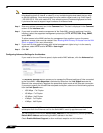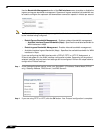
Network > Interfaces
230
SonicOS 5.8.1 Administrator Guide
Configuring the ADSL Expansion Module
ADSL is an acronym for Asymmetric Digital Subscriber Line (or Loop). The line is asymmetric
because, when connected to the ISP, the upstream and downstream speeds of transmission
are different. The DSL technology allows non-voice services (data) to be provided on regular
single copper wire-pair POTS connections (such as your home phone line). It allows voice calls
and data to pass through simultaneously by using higher band frequencies for data
transmission.
The SonicWALL ADSL module cards support only one subscriber ADSL line (one port). Two
types of ADSL module cards are supported:
• 1 Port ADSL (RJ-11) Annex A – ADSL over plain old telephone service (POTS) with a
downstream rate of 12.0 Mbit/s and an upstream rate of 1.3 Mbit/s.
• 1 Port ADSL (RJ-45) Annex B – ADSL over an Integrated Services Digital Network (ISDN)
with a downstream rate of 12.0 Mbit/s and an ups.tream rate of 1.8 Mbit/s.
The following ADSL standards are supported
The ADSL
module card uses 2 LEDs to indicate connectivity status. The upper green LED is
the ADSL link. Its status is as follows:
• OFF - No link
• ON - ADSL link is active
The lower green LED shows the system
and ADSL module activity.
• If it is OFF, there is no activity.
• If it displays a slow blink rate, it signifies activity on system management interface.
• If it displays a fast blink rate, there is data activity on ADSL line.
The ADSL module card is detected on boot, and assigned an
interface name of M0 or M1. The
interface name is based to it based on the expansion slot hosting the module card. You will see
the assigned entry when you log into the Network Interfaces page.
Standard Name Common Name
T1.413 ADSL
G.992.1 ADSL G.DMT
G.992.2 ADSL Lite (G. Lite)
G.992.3 ADSL2
G.992.5 ADSL2+M with Annex M and Annex L


















